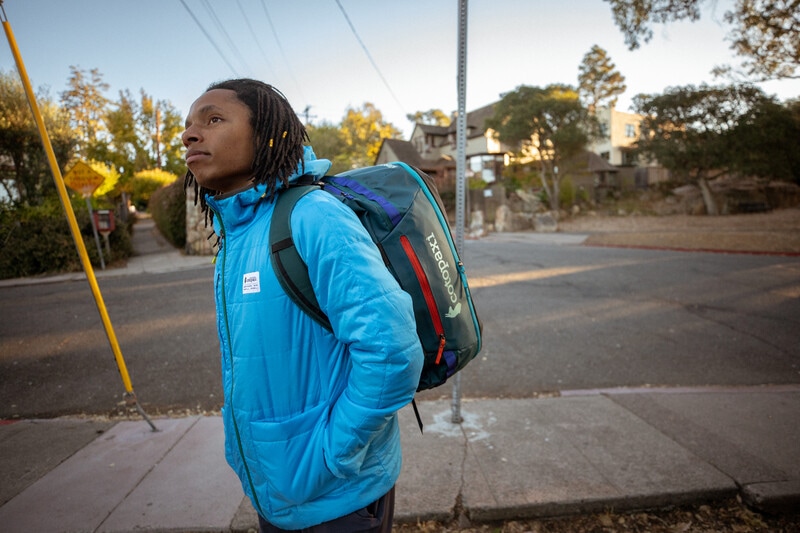If you assume Cotopaxi, you most likely assume brilliant colours: blocks of pink and goldenrod, stripes of lime inexperienced. Possibly you even have Cotopaxi’s basic windbreaker hanging in your closet, its vivid hues and retro design a welcome distinction to your extra understated outerwear. However Cotopaxi can be identified for one thing else: doing good.
The Cotopaxi group has lengthy understood the connection between individuals and planet: Research have proven that our financial, social and emotional wellbeing is intently linked to the well being and resilience of the pure world round us. That’s why the Utah-based model has made a dedication to combatting poverty in addition to to limiting the environmental footprint of its clothes manufacturing. However, it’s possible you’ll be questioning: What does clothes manufacturing should do with the planet? And the way does that relate to ending poverty?
On this story, we look at these questions by way of the Teca Cálido Hooded Jacket, a part of the model’s assortment of layers and fleeces made out of repurposed supplies. We have a look at how the jacket is designed, what supplies are used and, importantly, how all of this connects to serving to impoverished communities. We additionally discover what it means for you as a client if you buy from a model that prioritizes individuals and the planet—as a result of the place you spend your greenback issues.
Utilizing Upcycled Supplies to Defend the Planet
The supplies a model makes use of could make a huge impact on the setting. Producing artificial fibers for the textile business accounted for 1.35% of world oil consumption in 2021—that’s greater than the annual oil consumption of Spain.
Luckily, there are much less resource-intensive methods to create garments. For example, through the use of recycled or remnant supplies. For that motive, Cotopaxi goals to have each product adjust to no less than two of what its model leaders name the three Rs—remnant, recycled and accountable—by 2025. It’s an effort to create new wears utilizing supplies already in circulation.

So, what do the three Rs imply to Cotopaxi designers? Let’s look first at recycled and remnant. You’re doubtless most acquainted with the previous: Recycled cloth is often made out of recycled yarn, which may come from quite a lot of sources, together with plastic bottles and fishing nets, says Oriana Delgado, supplies growth supervisor at Cotopaxi. Remnant cloth, however, is materials that was produced however was not used. As a result of most materials have a shelf life of between six months and a yr (high quality decreases over that point), that leftover cloth may in the end find yourself in a landfill.
Within the case of the Teca Cálido Hooded Jacket, the outer layer is made out of remnant taffeta whereas the within contains 60 grams of recycled polyester insulation. The recycled insulation is what makes this jacket a strong weight for year-round actions like mountain climbing and biking. Through the use of recycled materials, Cotopaxi makes use of what’s already on the market and helps cut back its reliance on creating extra plastic, Delgado says. Utilizing remnant cloth provides a use to materials that would in any other case find yourself in landfills, that are a serious supply of climate-warming emissions.
After all, there will be challenges to utilizing recycled or remnant cloth, explains Annie Agle, senior director of influence and sustainability at Cotopaxi. For one, it takes further time for Cotopaxi groups to coordinate with the manufacturing facility on what accessible colours can be utilized. This could additionally restrict designers to what’s accessible, which influences the design prospects.
“If you’re utilizing recycled, repurposed supplies, you’re making an attempt to design in a approach that eliminates waste,” Agle says. “You don’t get to decide on the material. It’s important to have the design match the fabric and never the opposite approach round.”
However this design method is likely one of the driving missions behind Cotopaxi.
“Possibly at different corporations it’s a nice-to-have however not a requirement,” says Julie Hirsch, class director of product at Cotopaxi. “For us, if we are able to’t ship on the three Rs in a significant approach, we received’t launch the product.”
So, how a lot much less is your environmental footprint as a client if you buy outerwear made out of recycled or remnant supplies? A 2017 examine by the Federal Workplace for the Setting confirmed that recycled polyester may cut back emissions by as much as 32% in comparison with virgin polyester. Cotopaxi has used 250,000 yards of remnant cloth for its Teca assortment, holding almost one million yards of cloth from going to waste, in line with its 2021 influence report. To place that in perspective: That a lot cloth may stretch greater than 560 miles, or about twice the size of the Grand Canyon. So yeah, it’s loads.
Moreover, this insulated jacket is reversible, that includes the model’s vibrant signature hues on one facet and extra muted tones on the opposite. You primarily get two kinds from the jacket—one which seems brilliant on the path, and one other that pairs effectively with errand working within the metropolis. This flexibility is by design: It supplies choices, so you are able to do extra with a single jacket. And it’s at an approachable worth level, says Ben Doxey, an attire product designer at Cotopaxi.
The Intersection of Local weather and Humanity
Defending the setting is one piece of the bigger Cotopaxi mission, which is to assist elevate communities out of poverty. As a result of sure, the 2 are intertwined: Local weather change is a serious contributor to world poverty
A warming local weather can have an effect on communities in some ways, akin to by inflicting a rise in excessive climate occasions like hurricanes, wildfires and droughts. These disasters enhance monetary pressure by inflicting destruction to houses and sources and contributing to meals shortage, amongst different issues.

One other instance will be seen in locations like Latin America, Agle says. As a result of a warming local weather has contributed to deforestation on this area—and thereby altered the setting—some nations have seen a rise in malaria-carrying mosquitoes. Malaria can contribute to poverty as a result of it’s an costly ailment to deal with, Agle explains. Nevertheless, it’s reasonably priced to stop.
“Our mission has all the time been to finish excessive poverty in our lifetime, however poverty clearly, like all problem … is multifaceted. It’s complicated. It’s a transferring goal,” Agle explains. “We all know that local weather change is already actually harming communities.”
What position does a jacket play in all of this? When a model mitigates its use or manufacturing of planet-harming sources, it lessens its contribution to local weather change. That’s why making a jacket from recycled supplies issues—it’s making use of current supplies to stop them from going to a landfill and to chop down on the resource-intensive course of of creating new stuff from scratch.
Moreover, every year, the model allocates 1% of its income to its charitable arm, the Cotopaxi Basis, which supplies grants to nonprofits that assist combat poverty across the globe. These donations have a huge impact. In line with the model’s influence report, Cotopaxi helped greater than 1 million individuals in 2021.
So, the subsequent time you decide up a Cotopaxi jacket, whether or not it’s the Teca Cálido or the basic windbreaker, you’ll know that you just’re making a call past what is going to look cool on the path. (Although you undoubtedly will look cool on the path.) You’re additionally supporting a broader mission to guard the planet and its individuals. You’re serving to Cotopaxi do good by making good gear.

No responses yet